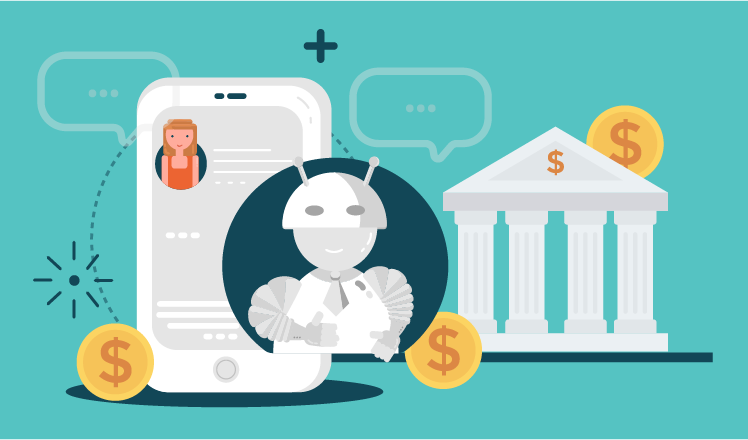Trend watch: Exploring the potential of chatbot banking
With the appearance of the Graphical User Interface (GUI) in the early 1980s, numerous websites and applications finally reached a wider audience. This became possible thanks to user-friendly GUI elements, such as icons, windows, menus, buttons, scroll bars and more. Nevertheless, the golden age of GUI-based applications seems to be gradually receding.

Conversational UI in focus
Recent innovations in voice processing and artificial intelligence have shifted developers’ focus from graphical UI to conversational UI. Thus, instead of clicking on icons, people can now interact with their devices by just sending questions and inquiries. Taking into account that Americans currently download zero apps per month on average and use only a few number of messaging and social apps on a daily basis, it’s no surprise that conversational UIs and chatbots in particular have been growing in popularity.
As the market is steadily booming, some even call 2017 the year of the bot. Actually, about 200 companies are developing chatbot solutions now. Let’s see how banks and their customers can benefit from this banking software.
The benefits of banking chatbots
For banks
- Reduce costs
Banks engage with customers through various channels that can range from in-person conversations in a branch and telephone calls with sales or service representatives to chats via digital channels, such as websites, mobile apps, e-mail and others. Though in-person interactions are the most effective, at the same time they turn out to be the most expensive for banks. Chatbots could reduce these costs while maintaining quick and high-quality customer service.
- Connect with Millennials
Using chatbots, banks can better reach Millennials and interact with them. Since Millennials are frequent users of mobile messaging services, such as Facebook Messenger, WhatsApp and SnapChat, banks that are on the same page with this generation have more chances to succeed.
- Promote new products and gather customer feedback
Since banks have a wide variety of products and services, customers may be simply unaware of new offerings. In this case, a bank bot will be of great help to send prompt notifications about new options available and gather feedback on whether they are relevant for a particular customer. Such feedback can help banks to deliver more personalized messages in the future.
- Provide personalized customer support and faster issue resolution
For banks that strive to gain market leadership, delivering excellent customer service should be one of the main priorities, as it motivates customers to come back. Chatbot banking can ensure customer support 24/7 as well as provide customers with content that cannot be easily found on the website and in the mobile banking app.
For customers
Unlike websites or banking apps, holding a conversation with a banking bot is very simple, which can become a winning point for customers. Thus, instead of logging into a website or running an app, customers can ask a banking bot to help with the most frequent issues, such as checking balance or a history of recent transactions.
Besides, a banking bot can bring many other benefits for customers, such as:
- remind them about due payments
- suggest various options how to save money
- inform them about new financial products
- periodically show the balance
- provide an investment portfolio update
- deliver valuable information and time-sensitive notifications
- chat with customers while they’re abroad and stop their card activity when necessary (e.g., to prevent fraud activities).[1]
Ensuring information security in banking chatbots
A recent study from GfK shows that six of ten customers worry about information security while using chatbots. For this reason, banks should ensure high-quality data encryption to keep safe sensitive customer data. Banks should also verify the location of the device and check that the device belongs to that particular customer. To make the interaction with a chatbot even more secure, banks can require biometric authentication before initiating transactions or sharing personal information.
Bank chatbots still at the pilot stage in the US
For now, most chatbot projects in banking remain in the trial phase – to avoid fiascos similar to those with Microsoft’s AI chatbot or Amazon’s Alexa in the sensitive banking industry.
Among the banks experimenting with chatbots is Wells Fargo, which recently collaborated with a fintech firm Kasisto to launch a six-month pilot in Facebook Messenger. The bot assistant can tell customers their account balance, show the closest ATM or a physical branch and display recent expenses on food or at particular retailers, such as Starbucks.
Another example comes from Bank of America, which is training its chatbot Erica to provide personal financial advice. For example, Erica will be able to track a customer’s credit score and in case it drops, the bot will provide free online courses that show how to bring it up again. The bot will also give advice on how customers can save more or reduce the debt.
In search for a ‘perfect’ banking bot
Though banking chatbots are still at the pilot stage in the U.S., the technology itself has a promising future, and successful examples of chatbots used in East Asia have already proved it.
A Chinese chatbot called WeChat grew from a plain messaging service in a portal where users can do almost everything. With over 889 mln users and 10 mln business accounts, WeChat has become a full-range product and service provider. Using WeChat, customers can not only order goods and services, but also perform various financial activities, such as paying bills, putting money to a savings account or even applying for a loan.
Banking chatbots are not ready to replace a customer service representative or a financial advisor completely, yet. However, current achievements in the banking industry prove that chatbots can be customer-focused and cost-effective thereby meeting the needs of both banks and their customers.
[1] This can be extremely beneficial for banks, as they can use chatbots to cross-sell products for travelling, such as insurance, or timely display exchange rates.

